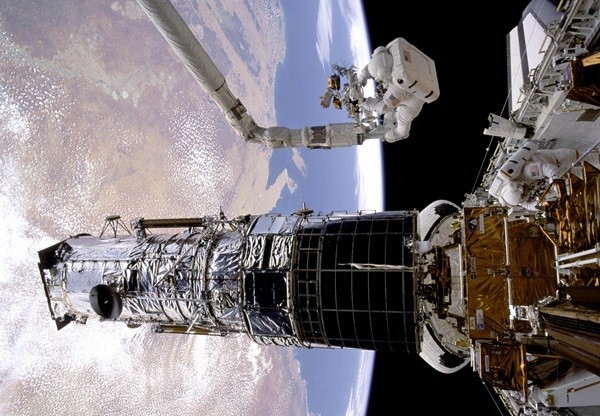Hubble waylaid by computer fault

Astronauts repair the Hubble Space Telescope during the first servicing mission to the observatory in 1993, flown by the space shuttle Endeavour.
NASA engineers are working to diagnose a computer glitch that has put the Hubble Space Telescope out of commission.
The good news is that the core scientific instruments and the telescope itself remain in good health. And there are on-board backups for the systems suspected to be at fault, which are part of an assemblage of components called the Science Instrument Command and Data Handling (SI C&DH) unit. But so far, Hubble’s team hasn’t identified which piece of hardware is at the root of the failure. And turning on those backups will be an intricate procedure that is risker than some of the steps tried so far.
The issue emerged on June 13 when its payload computer — which manages the science instruments — ground to a halt. This prompted the main computer to put the instruments into a “safe mode.” Telescope controllers attempted to restart the payload computer the next day, but ran into the same problem.
Initially, the Hubble team suspected a faulty memory module, but switching to a backup memory module didn’t resolve the issue. Attention then shifted to components of the payload computer itself. In tests on June 23 and 24, NASA turned on the backup payload computer for the first time since it was installed during a shuttle service mission in 2009. But that didn’t fix the problem, either: Hubble was still getting errors writing to and reading from the memory modules.
NASA is now looking at other onboard equipment to find the culprit. One possibility is the Command Unit/Science Data Formatter (CU/SDF), which formats and routes data onboard and for transmission to the ground. The team is also investigating the power regulator for potential voltage spikes or drops. Both the CU/SDF and the power regulator have backups that may be called into service in the coming days.
“This procedure would be more complex and riskier than those the team executed last week,” NASA said today in a statement, referring to trying the backups for the payload computer and memory modules. “To switch to the backup CU/SDF or power regulator, several other hardware boxes on the spacecraft must also be switched due to the way they are connected to the SI C&DH unit.”
The team is already preparing for that process, reviewing the operations procedures and commands for testing in a simulator, NASA said.
Showing its age
Such glitches are not unprecedented on Hubble. The current CU/SDF is a replacement for one that failed in 2008. That failure forced a switch to the backup in a procedure similar to the one currently under consideration. Fortunately, it was successful. Even better, a shuttle servicing mission was already scheduled; by delaying it, NASA got the opportunity to build a replacement SI C&DH unit.
The telescope’s gyroscopes — which were also replaced during that 2009 service mission — have been acting up, as well. In October 2018, one of those gyros, which help keep the telescope stabilized during observations, stopped working, and its backup failed to come online. However, after rotating the telescope and cycling the backup gyro through different modes, the team was able to recover it.
Hubble fell into safe mode again just four months ago due to a bug in a telescope software update that created a permissions error. That was quickly patched and Hubble resumed normal operations within a week.
So far, none of these issues have proven fatal. And while they are a steady reminder that the fabled observatory will not be around forever, scientists hope it has many years of operations ahead of it.
“The team working on Hubble recovery are masters of engineering and very cautious,” tweeted John Grunsfeld, one of the astronauts who repaired Hubble in 2009. “I’m optimistic they will succeed.”
Source: Astronomy Magazine